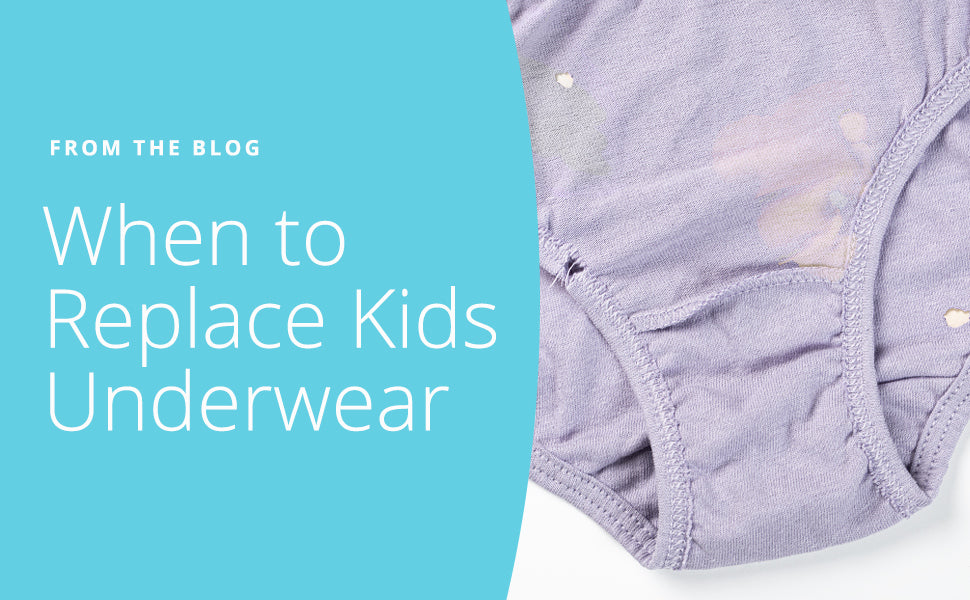
When it comes to underwear, there isn't a steadfast rule on when the proper time is to replace them. And if you're like many of the parents we've spoken to over the years, this subject often leaves them with a big question mark. Let's face it: it's different from the topic of discussion at our kids' little league games or play dates.
Knowing when to replace your child's underwear can be influenced by several factors. In addition to growing out of their clothes as all children do, their personal hygiene habits (or lack thereof), the durability of the underwear, and how comfortable your child is in them are all components to consider. But how do you know for sure it's time to replace them?
This post will discuss when it's time for new undies, what to look for in those new underwear (to get the most bang for your buck), and how to speak with your child about personal hygiene and its importance.

Signs It's Time for a Change
If you're one of the lucky few whose parents buy their grandchildren new underwear every year, then you may not worry so much about when to replace your child's underwear. But if you don't fit into that category, or even if you do but have an inkling, you may need to do a mid-year underwear shopping spree. Then, the list below will give you a good idea of when it is actually time to toss those old underwear and be on the hunt for some new undies.
Wear and Tear
This one may seem the most obvious, but it's not. As parents, our lives can get busy, so we probably aren't inspecting our children's underwear for holes every two weeks. But that's precisely what we need to do. Well, not the every two weeks part, you get the point.
Children's underwear, especially those of lesser quality fabrics, is prone to wear and tear. We all know children can be hard on their things, and their underwear is no different. And if it wasn't them, you can blame the washing machine. Most underwear can't withstand 15 washes, let alone over 25, equivalent to 6 months of weekly wear.
Take time to inspect their undergarments for visible signs of wear and tear. Look for holes, frayed edges, or stretched-out elastic. No one wants to be the parent of the kid with a big hole in the top of their underwear running around the playground.
Fading Colors and Fabric Deterioration
Fading colors are the worst, especially when that's the main reason you bought the underwear in the first place. Let's not mention if you have a nautical-obsessed little one who will only leave the house in their coastal-themed boxer briefs.
The truth is that colors fade and fabric deteriorates after so many washes and wears. It's inevitable. How long that takes to happen is the key. The higher the fabric quality, the longer the underwear will last. The higher quality the fabric is, the less likely it is to decline, meaning there is less chance of bacteria being trapped in the material no matter how much they are washed. We don't even want to imagine what that can mean for little ones.
Instead, let's talk about choosing underwear made of durable materials that will withstand regular washing and keep bacteria out.
First, material, material, material. We can't stress enough how important it is to know what your child's underwear is actually made of. Things can get tricky with all the synthetic fabrics. Polyester this, nylon that. When in doubt, pick cotton.
Cotton is by far the best fabric for underwear. Other materials can deteriorate faster, and some have been known to lock moisture and bacteria in. Creating a breeding ground for infection. Opt for organic cotton when you can. Cotton blends that are more than half cotton are a great second choice. Modal cotton is known for its incredibly soft feel with fantastic breathability. It also absorbs moisture very well and is one of the more durable fabrics due to how tightly it is woven together.
Size Matters
It's the night before the holiday play at school. Full of glee and excitement, your child tries on their ensemble. They are eager to dance around and practice the songs they've spent the past few weeks learning. But then you notice they've outgrown their shoes. The ones you just bought them two weeks prior.
We've all been there. Children grow like weeds. So, it's safe to assume they can grow out of their underwear just as fast. This is why checking our children's underwear for overall fit is essential.
Wearing too-tight underwear can cause constant fidgeting, chafing, and potential infections, as bacteria is stuck against the skin for long periods. Underwear that is too tight around the upper thigh can also cause blood flow issues, resulting in tingling, loss of circulation, skin irritation, and numbness.
On the opposite end of the spectrum, when a child has too-loose underwear, they don't get the support that underwear is meant to provide. The extra fabric can also bunch, making it highly uncomfortable for them when sitting, standing, or playing.
Hygiene Considerations
Beyond wanting our children to be comfortable, we can all agree that their health precedes most of our decisions. That sentiment still rings true when it comes to replacing their underwear.
From the day they are born, children are constantly learning. They learn to crawl and talk, memorize the alphabet, and learn addition and subtraction. They are potty trained and master how to properly wipe themselves. We as parents must prioritize their hygiene during these times and well into their childhood years.
Bacterial Buildup
As we mentioned earlier, lower-quality underwear, typically made of synthetic fabrics, tends to allow bacteria to build up. The older and more worn-out the underwear, the easier it is for that to happen.
Knowing this ahead of time can help us prevent it. In addition to opting for underwear made of organic cotton, modal cotton, or underwear that is predominantly cotton, there are steps we can take to help maintain our child's underwear.
The best way to avoid infection and bacterial spread is to wash underwear separately with a gentle soap using the proper water temperature. It's also beneficial to clean our washing machines regularly.
Helping our kids maintain clean underwear can prevent bacterial buildup and decrease the risk of skin irritation and infections.
Odor Control
Maybe it's just our kids, but we've experienced the “my kid has a favorite item phase”. Their favorite shirt, favorite shorts, or even their favorite underwear. Which ultimately comes with their refusal to hand those items over to be washed. And while this certainly can be adorable, overused and unwashed underwear can lead to unpleasant odors.
When you can wash those favorite undies, hand washing them is the best way to control odors. However, if this isn't an option, wash them cold separately with a gentle soap.
Age-Appropriate Conversations
As our children age, our conversations with them change, including their personal hygiene. Once your child has started wiping themselves, the need for these conversations dramatically increases.
Teaching Hygiene Habits
These topics may not always seem fun, but they are essential in teaching our children how to properly care for themselves, including identifying when to replace their underwear.
As a parent, you don't have eyes in the back of your head- or, better said, you can't see it all. Speaking to your child and teaching them how to tell when their underwear needs to be replaced can take one more thing off your to-do list.
When having these conversations, it is excellent to use visuals. For example, you can show them what overworn underwear looks like and take a moment to explain how bacteria can build up in old underwear and cause infections and skin irritations.
No matter their age, there are ways to make these conversations age-appropriate. Using visuals, examples of what you look for when choosing to replace your underwear and even videos of what bacteria can do to the body are all helpful ways to ensure your child understands the importance of clean, well-fitting underwear.
Empowering Independence
During these conversations, it's essential to empower their independence. The topic of underwear can feel taboo for some. Talking about something so close to their body can make them feel shame or even embarrassment.
Try to foster confidence in them by empowering them to inform you when they need new underwear. Allow your child to inspect their underwear and report back to you if it is time or not for a replacement. This can inspire them to be more independent and shed some of those feelings of shame and embarrassment.
Shopping Tips for Parents
Now that we've explained how to tell when to replace underwear, it's time to focus on what to look for when that time comes.
Buying new underwear may seem relatively easy. Most retailers sell them, and it's easy to find super cute patterns you know your child will love. However, there's more to it than that. At least if you want quality, comfortable underwear for your child.

Quality Over Quantity
We all want to get the best bang for our buck. We want to get the most we can for the least amount. And while this can be beneficial in some instances, it can be detrimental when it comes to our children's underwear.
Quality underwear means more than just premium fabrics. It means quality fabrics that don't trap bacteria. It means underwear that lasts wash after wash- no fading, tearing, or overstretched elastic. Quality underwear lasts. In the long term, buying quality will save us money.
Age-Appropriate Designs
Of course, we also want to make our children happy, and choosing underwear with designs that appeal to our children's age and interests is helpful. Maybe they love dinosaurs or are llama fanatics. Whatever the case, purchasing designs that make them happy will make it more enjoyable for our kids. Who doesn't want to get dressed when their favorite comfy undies are covered in cute bunnies or stars and stripes?
Let's summarize the key points in this post. It is vital to examine our children's underwear occasionally to ensure they are not worn out. Look for fading colors, fabric deterioration, holes, and overstretched elastic, as these all point to the underwear needing a replacement.
We can extend the life of our children's underwear, outside of when they have outgrown them, by buying quality underwear. Composed of primarily cotton (at least 50%), well-fitting on their upper thighs, comfortable around their waistband, and crafted with designs they love, all indications of quality underwear.
Lastly, speaking to our children about their personal hygiene and empowering them to actively participate in it is vital. Not only does it foster independence, but it can also help eliminate any shame they may feel around the topic, especially when getting new pairs of underwear.
While there is no hard or fast rule about when to replace underwear, we hope this post helps you determine the best time to do so for your child.
No matter the time frame, when it is time to replenish your child's underwear drawer, we hope you choose Lucky & Me.


